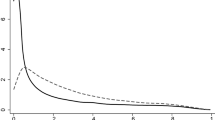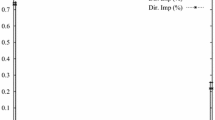Abstract
This paper documents that a large fraction of trade flows at the firm level consists of simultaneous imports and exports in identical products, narrowly defined at the 8-digit product classification, which we call pass-on trade (POT). We use data on imports and exports at the firm and product level for Slovenian manufacturing firms in the period 1994–2008, to show that, on average, 70 % of all exporting firms engage in POT. This corresponds to more than 50 % of all exported products. Thus, imported products that are exported again by the same firm is a statistical regularity of trade of Slovenian manufacturing firms. We document that the use of POT is increasing in firm size, product diversification, multinational status as well as firm productivity and profitability. We offer and explore empirically a number of explanations for POT. Among possible explanations, we find evidence on the importance of firms’ multinational networks and demand complementarities between firms’ own and POT products. The latter confirms the theoretical explanations for carry-along trade (CAT) as developed by the recent work of Bernard et al. (2012).

Similar content being viewed by others
Notes
Since we have no information on domestic production, we cannot compute the extent of CAT. But it is likely that POT is closely related to CAT as documented by Bernard et al. (2010d, 2012). As shown later in this paper, CAT may account for total local and international sourcing of products, while POT entails only internationally sourced products that have been passed-on to exports.
See Online Appendix 1 for more details on the coverage of trade data.
See Online Appendix 1 for a detailed description of the applied CN year-to-year corrections. As shown in Table 13 in Online Appendix 1, periodic changes in the CN code and corrections of the codes do not have a substantial impact on the average number of exported products and hence do not affect significantly the product churning rates.
Note that the export numbers are somewhat higher than those reported for other countries. Bernard et al. (2010c) report for the United States that 58 % of exporters are multi-product and account for more than 99 % of exports. For Belgium, 65 % of all exporters are multi-product and account for more than 98 % of exports (Bernard et al. 2010d).
At the same time, importers and exporters dominate in every respect the whole manufacturing sector as our sample consists of all manufacturing firms with non-zero employment.
In a companion paper, Damijan et al. (2012) document these facts in more detail.
Note that Table 3 includes also products, which can be re-introduced in exports and imports. Table 14 in Online Appendix 2 shows a variant of Table 3 without including re-introduced products to the statistics of added and dropped products. Without re-introduced products the figures for added and dropped products in exports are lower by 27 %, while in imports these figures are lower by 33 %. This indicates that there is a substantial product churning going on in Slovenian exporting and importing as roughly 70 % of all added products consist of products, which are new to the firm (i.e., have never been exported/imported before). Similarly, about 70 % of all dropped products are dropped forever (i.e., will not be exported/imported again).
Iacovone and Javorcik (2010) document gross churning rates of 30 % for Mexican exported products, while these figures in Slovenia are doubled.
The clearing period can also be either shorter or longer. In Online Appendix 3 we provide some robustness checks using different lenghts of the clearing period, but the extent of POT does not vary significantly with the length of the clearing period.
In Online Appendix 3 (see Table 15) we also provide robustness checks regarding the aggregation level of products. We find that that for reasonable variations in the level of aggregation (CN-8 vs. CN-6) POT phenomenon seems to be very robust.
Note that we use a rather restrictive measure of POT referring only to simultaneous two-way trade in the same products and hence accounting only for international sourcing. We also restrict the maximum export value of each POT product to the average import value during the recent and previous year, and, hence, we do not account for potential domestic sourcing of products. Bernard et al. (2012) compare firm’s own production with firm’s exports of the same products and hence account also for domestic sourcing of products. They find that more than 90 % of Belgian exporters export more than they produce and that CAT accounts for more than 30 % of total export value.
Though the efficiency of OLS estimator may suffer due to unobserved firm heterogeneity, the use of fixed effects (FE) regression is not appropriate in this case. Since FE regression captures firms’ deviations from their own long-term average, the interpretation of results obtained by this type of regression on dummy variables for different degrees of POT is cumbersome. The FE regressions will in fact identify only firms that changed their POT engagement over time to a lower or higher degree as measured by the POT dummy variables. Hence, FE regressions will estimate a correlation between a switch in the POT dummy and a change of the dependent variable. Switches in the POT dummy variables are rare and, hence, the results obtained by FE regressions are not very informative.
Stylized data above shows that for an average exporter the number of POT products is larger than the number of non-POT products.
The overall marginal cost here refers to either total cost of development and placement of own products or to total cost of proprietary or non-proprietary sourcing and placement of sourced products. Proprietary sourcing referrs to establishing own affiliate abroad or to develop a product and outsource its production to outside firms. Non-proprietary sourcing instead referrs to simple purchasing of ready-made varieties abroad.
See Damijan et al. (2011) for a direct comparison of export dynamics of both groups of exported products.
References
Ahn, J., Khandelwal, A., & Wei, S. (2010). The role of intermediaries in facilitating trade (NBER Working Paper 15706). Cambridge, MA: National Bureau of Economic Research.
Akerman, A. (2010). A theory on the role of wholesalers in international trade based on economies of scope (Research Paper in Economics 2010:1). Department of Economics, Stockholm University.
Balassa, B. (1986). The determinants of intra-industry specialization in United States trade. Oxford Economic Papers, 38(2), 220–233.
Bas, M., & Strauss-Kahn, V. (2010). Does importing more inputs raise exports? Firm level evidence from France (MPRA Paper 27315). University Library of Munich: Munich Personal RePEc Archive.
Bernard, A., Jensen, B., Redding, S., & Schott, P. (2007). Firms in international trade. Journal of Economic Perspectives, 21(3), 105–130.
Bernard, A., Grazzi, M., & Tomasi, C. (2010a). Intermediaries in international trade: Direct versus indirect modes of export (Research Working Paper 199). Brussels: National Bank of Belgium.
Bernard, A., Jensen, B., Redding, S., & Schott, P. (2010b). Wholesalers and retailers in U.S. Trade (NBER Working Paper 15660). Cambridge, MA: National Bureau of Economic Research.
Bernard, A., Redding, S., & Schott, P. (2010c). Multi-product firms and product switching. American Economic Review, 100(March), 70–97.
Bernard, A., Van Beveren, I., & Vandenbussche, H. (2010d). Multi-product exporters, carry-along trade and the margins of trade (Research Working Paper 203). Brussels: National Bank of Belgium.
Bernard, A., Redding, S., & Schott, P. (2011). Multi-product firms and trade liberalization. Quarterly Journal of Economics, 126(3), 1271–1318.
Bernard, A., Blanchard, E., Van Beveren, I., & Vandenbusche, H. (2012). Carry-along trade. Hanover: Dartmouth College, Mimeo.
Brander, A. J. (1981). Intra-industry trade in identical commodities. Journal of International Economics, 11(1), 1–14.
Damijan, J. P., Konings, J., & Polanec, S. (2012). Import churning and export performance of multi-product firms (LICOS Discussion Papers 307/2012). Centre for Institutions and Economic Performance, K.U. Leuven.
Damijan, J. P., Kostevc, Č., & Polanec, S. (2011). Export strategies of new exporters: Why is export expansion along the extensive margins so sluggish? (LICOS Discussion Papers 277/2011). Centre for Institutions and Economic Performance, K.U. Leuven.
Di Comite, F., Vandenbussche, H., & Thisse, J. (2012). Verti-zontal differentiation in monopolistic competition (CEPR Discussion Paper 8752). London: Centre for Economic Policy Research.
Eckel, C., & Neary, P. J. (2010). Multi-product firms and flexible manufacturing in the global economy. Review of Economic Studies, 77(1), 188–217.
Goldberg, P., Khandelwal, A., Pavcnik, N., & Topolova, P. (2010a). Imported intermediate inputs and domestic product growth: Evidence from India. Quarterly Journal of Economics, 125(4), 1727–1767.
Goldberg, P., Khandelwal, A., Pavcnik, N., & Topolova, P. (2010b). Multi-product firms and product turnover in the developing world: Evidence from India. Review of Economics and Statistics, 92(4), 1042–1049.
Görg, H., Kneller, R., & Muraközy, B. (2008). What makes a successful exporter? Evidence from firm-product level data (CEPR Discussion Paper 6614). London: Centre for Economic Policy Research.
Greenaway, D., & Milner, C. R. (1983). On the measurement of intra-industry trade. Economic Journal, 93(372), 900–908.
Grubel, H. G., & Lloyd, P. J. (1975). Intra-industry trade. London: Macmillan.
Halpern, L., & Muraközy, B. (2011). Firm size and extensive margin: Hungarian exports. Economic and Business Review, 13(1–2), 27–50.
Heckman, J. J. (1979). Sample selection bias as a specification error. Econometrica, 47(1), 153–161.
Iacovone, L., & Javorcik, B. S. (2010). Multi-product exporters: Product churning, uncertainty and export discoveries. The Economic Journal, 120(May), 481–499.
IMF (1993). Balance of payments manual (5th ed.). Washington, DC: International Monetary Fund.
Krugman, P. (1979). Increasing returns, monopolistic competition, and international trade. Journal of International Economics, 9(2), 469–479.
Krugman, P. (1980). Scale economies, product differentiation and the pattern of trade. American Economic Review, 70(5), 950–959.
Mayer, T., Melitz, M., & Ottaviano, G. (2011). Market size, competition, and the product mix of exporters (NBER Working Paper 16959). Cambridge, MA: National Bureau of Economic Research.
Melitz, M. J. (2003). The impact of trade on intra-industry reallocation and aggregate industry productivity. Econometrica, 64(6), 1695–1725.
Muûls, M., & Pisu, M. (2009). Imports and exports at the level of the firm: Evidence from Belgium. World Economy, 32(3), 692–734.
Olley, G. S., & Pakes, A. (1996). The dynamics of productivity in the telecommunications equipment industry. Econometrica, 64(6), 1263–1297.
Petropoulou, D. (2007). Information costs, networks and intermediation in international trade (Economics Series Working Papers 370). Department of Economics, University of Oxford.
Rauch, J. E. (2001). Business and social networks in international trade. Journal of Economic Literature, 39(December), 1177–1203.
Rauch, J. E., & Watson, J. (2004). Network intermediaries in international trade. Journal of Economics & Management Strategy, 13(1), 69–93.
Verdoorn, P. J. (1960). The intra-block trade of Benelux. In E.A.G. Robinson (Ed.), Economic consequences of the size of Nations. Proceedings of a conference held by the International Economic Association. London: Macmillan.
Volpe, C., & Carballo, J. (2009). Survival of new exporters in developing countries: Does it matter how they diversify? (IDB Working Paper Series 9291). Washington, DC: Inter-American Development Bank.
Author information
Authors and Affiliations
Corresponding author
Additional information
The paper has benefitted from discussion with participants of the ISGEP 2011 workshop (University of Lüneburg), seminars at the University of Ljubljana and UC Louvain, as well as the EBR 2011 Conference (University of Ljubljana), EITI 2012 Conference (Keio University, Tokyo) and LETC 2012 conference (University of Ljubljana). We are grateful to the Slovenian Statistical Office for allowing us to access and analyze confidential data on international trade transactions.
Electronic supplementary material
Below is the link to the electronic supplementary material.
About this article
Cite this article
Damijan, J.P., Konings, J. & Polanec, S. Pass-on trade: why do firms simultaneously engage in two-way trade in the same varieties?. Rev World Econ 149, 85–111 (2013). https://doi.org/10.1007/s10290-012-0138-x
Published:
Issue Date:
DOI: https://doi.org/10.1007/s10290-012-0138-x




